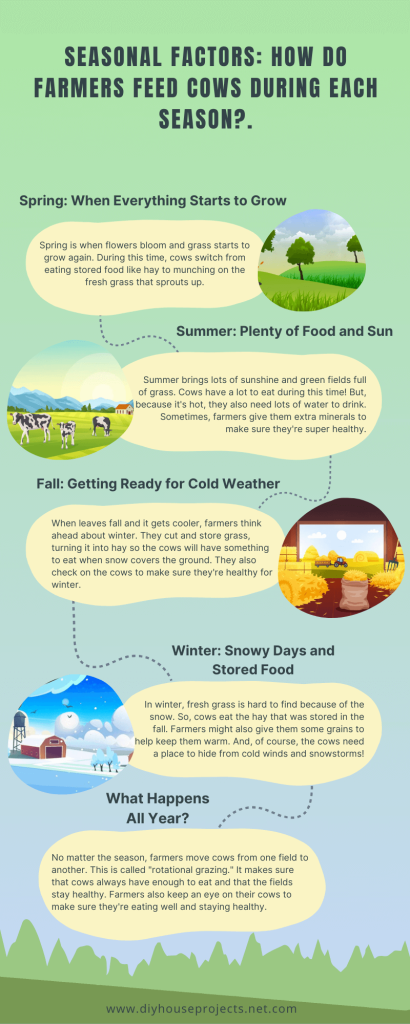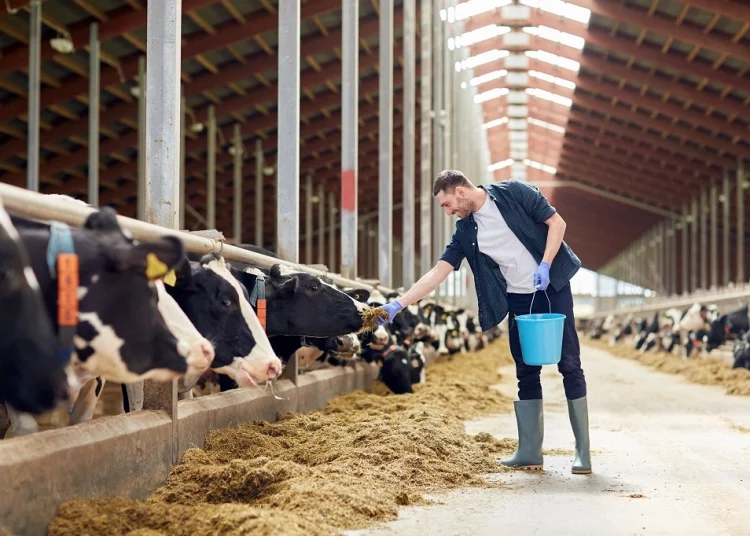Hay is very important for both farmers and ranchers. It is typically made from herbaceous plants, grass, or legumes, and those different grasses and plants can be made into Fodder.
Even those who have pets like guinea pigs or rabbits will want to buy them, especially as winter approaches.
Cows need a properly balanced diet to stay healthy and happy. They need to get enough nutrients. During summer, when grass is abundant, and the cows can graze, they typically eat grass. However, during winter, farmers will typically use preserved maize or silage.
Since most of the time, we only see cows eating grass, we end up wondering whether or not cows can eat hay. Read on and learn more about how you can keep your cattle healthy even when the grass is scarce or when winter is just around the corner.
Understanding a Cow’s Natural Diet: Pasture vs. Feedlot
When we think of cows, pastoral images of these gentle animals grazing on lush, green fields might be the first thing that springs to mind. But not all cows have the luxury of freely grazing on expansive pastures.
The place and manner in which cattle are raised can vary greatly, and it can be broadly classified into two categories: pasture and feedlot.
In a pasture setting, cattle freely roam and graze on grass or other native vegetation. This traditional method of raising cattle is closest to a cow’s natural diet and habitat.
Such a setting not only allows the cows to consume a natural diet of grass but also lets them move around, leading to leaner meat.
Pasture-raised cows often have a more diverse diet, thanks to the variety of grasses and plants available to them, which can contribute to a unique flavor profile in their meat or milk.
Feedlots, on the other hand, are a more modern approach to cattle farming, optimized for efficiency and high production. Here, cows are confined in smaller spaces and are primarily fed grain-based diets, including soy, corn, and other supplements.
This controlled diet aims to fatten the cows up more quickly for slaughter. While feedlots can be more efficient in meat production, critics argue that it may compromise the quality of the meat and the overall well-being of the animals.
Both methods come with their sets of advantages and challenges. Pasture-raised cattle require more land and time to reach their market weight, but their meat is often touted as more flavorful and natural.
Feedlot cattle, however, grow faster and can be more profitable for farmers, though there are concerns regarding their environmental impact, potential antibiotic use, and animal welfare.
The Difference Between Grass-Fed And Grain-Fed Cattle
Although all cows will start by consuming milk, they will be given different diets as they grow. Some farmers want them to be fed mainly with grass, while some prefer to give their cattle grain so that they will be able to gain a lot of weight or fat content.
The cow’s diet has a direct impact on the nutrients that can be found in the meat. Cows raised naturally are typically given a diet of grasses or other herbaceous plants. In most cases, grass-fed cows make natural, free-range, or organic beef or dairy products.
The Nutritional Benefits of Hay vs. Grass for Cattle
Understanding the nutritional profile of hay and grass is essential for cattle owners, as it directly affects the livestock’s health, growth, and production.
While hay and grass are fundamental to a cow’s diet, their nutritional values can differ based on numerous factors, such as the growth stage at harvest, storage conditions, and the type of grass or legume.
Here’s a comparative look at the nutritional benefits of hay and grass for cattle:
1. Nutrient Composition
- Grass: Fresh grass is rich in water content, making it a hydrating source for cattle. It also contains readily available nutrients, such as soluble carbohydrates, vitamins, and essential fatty acids. The high moisture and sugar content in fresh grass can provide immediate energy to the livestock.
- Hay: Being dried grass or legumes, hay has a lower water content but a higher concentration of certain nutrients, making it calorically denser. Drying can reduce vitamin content, but minerals like calcium and phosphorus remain relatively stable.
2. Digestibility
- Grass: Fresh grass is often more digestible than hay due to its moisture content and the presence of live enzymes that aid in digestion.
- Hay: The digestibility of hay can vary based on the plant’s maturity when harvested. Younger plants are more digestible than older, stemmier plants. Properly cured hay retains more nutrients and is more digestible than poorly cured or stored hay.
3. Fiber Content
- Grass: Grass provides good fiber, essential for proper rumen function. Young, leafy grasses are particularly high in digestible fibers that promote healthy digestion and fermentation in the rumen.
- Hay: Hay, especially from mature plants, can be higher in indigestible fibers. While this can benefit roughage, it may not provide as much energy as the digestible fibers in fresh grass.
4. Consistency and Availability
- Grass: The nutritional content of grass can fluctuate based on the season, weather conditions, and the growth stage. Its availability can be limited during colder months in many regions.
- Hay: One of the hay’s primary benefits is its consistency and year-round availability. Properly stored hay provides a stable source of nutrients for cattle during seasons when fresh grass is scarce.
5. Supplements and Additives:
- Grass: Fresh grass seldom requires supplements, as it is often rich in necessary nutrients, especially when rotated and managed properly.
- Hay: Depending on the quality and type of hay, supplements might be necessary to ensure cattle receive all required nutrients, especially if the hay is from older, less nutritious plants or has degraded during storage.
Fresh grass is an excellent source of energy, vitamins, and digestible fibers. At the same time, hay provides consistency and stability in a cattle’s diet, especially during seasons when pasture is unavailable.
The key for farmers and ranchers is to understand the specific needs of their cattle and adjust their feeding strategies accordingly, ensuring the livestock remain healthy and productive.
You might be interested: Spring into Gardening: How to Start a Garden for Beginners
Can Cows Eat Hay?
Cows can eat grass, and because hay is dried grass bundled and stored for future use, they can also eat hay. Cows can eat hay made up of alfalfa, Bermuda, brome, and even sorghum.
They can also eat pellet range. But should they be given hay? Even though cows can eat hay, it does not mean that they should eat hay.
This simply means that cows can eat hay depending on whether the cow is grass-fed or grain-fed and whether the cow is grass-finished or grain-finished.
This is because their diet must be observed so you can get the right results. Grass-fed cows, for example, will only be given grass during their lifetime to keep the quality of their milk or meat intact.
During winter, when grass is not readily available, they are typically given hay so they can still produce natural or organic beef. Grass-finished cows can also be given hay during winter or when they cannot graze.
Grain-feed cows, on the other hand, are typically given corn and soy. Some cows that need to be fattened quickly cannot be given hay. Instead, they are placed in feed lots and made to eat a diet of only grains.
In some cases, cows can eat hay if no other fodder is available. Some farmers or ranchers will store hay or buy hay to keep their cattle in good condition during winter.
In some countries or areas, cows cannot eat hay because it is not available. Silage is used to feed them instead.
Seasonal Factors: How Farmers Adjust Cattle Feed Throughout the Year
Farmers and ranchers understand that the changing seasons can greatly influence their cattle’s availability and quality of forage. Adapting to these shifts is crucial for maintaining the health and productivity of their livestock.
Here’s an in-depth look at how farmers adjust cattle feed throughout the year based on seasonal factors:

1. Spring: The Awakening of Pastures
- Fresh Growth: As temperatures rise, pastures begin to show new growth. This fresh grass is tender, highly digestible, and rich in nutrients, making it a preferred feed source for cattle.
- Transitioning from Hay: As fresh grass becomes available, farmers gradually shift their cattle from a hay-based diet to pasture grazing, ensuring a smooth transition for the animals’ digestive systems.
2. Summer: Abundance and Monitoring
- Peak Grazing: Summer provides an abundance of grass, allowing cattle to graze freely. This is often the period when livestock gain the most weight.
- Water Intake: With rising temperatures, farmers need to ensure cattle have access to ample clean water to stay hydrated.
- Supplements: Depending on the quality of the pasture and soil fertility, mineral supplements might be provided to cover any nutritional gaps.
3. Fall: Preparing for Winter
- Gradual Shift: As grass growth slows with cooling temperatures, farmers reintroduce hay and other stored feeds to prepare cattle for the winter months.
- Harvesting and Storing: Fall is a crucial period for haymaking. Farmers harvest and store hay to ensure a consistent feed supply during winter.
- Body Condition Monitoring: Farmers closely monitor their cattle’s body condition, ensuring they have adequate fat reserves for the colder months ahead.
4. Winter: Reliance on Stored Feed
- Hay and Silage: With pastures often covered in snow or dormant in colder climates, cattle predominantly rely on stored feed like hay and silage.
- Grain Supplements: Some farmers introduce grains to the cattle’s diet to provide additional energy and ensure the livestock maintain their weight during the cold months.
- Protection from Elements: Beyond feed adjustments, farmers provide shelter or windbreaks to protect cattle from harsh winter conditions.
5. Year-Round Considerations
- Rotational Grazing: To ensure sustainable pasture health and maximize forage availability, many farmers practice rotational grazing, moving cattle between pastures to prevent overgrazing and allow grasses to recover.
- Nutritional Monitoring: Regardless of the season, it’s essential to monitor the nutritional intake of the cattle, adjusting as needed based on the animals’ health, weight, and specific needs like lactation or growth.
Can You Really Grow All Your Cattle Need?
Absolutely! The key lies in aligning the number of your cattle with the size of your pasture and hay cultivation area.
Typically, you might need about 2 to 3 acres per cow-calf pairing, though this can differ based on factors like terrain, plant types, soil fertility, the specific needs of the animals, and various environmental conditions.
It’s possible to strike a sustainable balance over time by strategically using a mix of warm and cool forages for both grazing and hay. Techniques such as rotational grazing can further boost the land’s capacity and optimize fodder usage.
Conclusion
Since cows can eat grass, they can also eat hay. It can be used to provide 100% of the fodder requirements of cattle. However, cows cannot eat hay that contains molds or is spoiled. They also cannot eat hay made from plants that are toxic to them when fresh.
When it comes to hay, you must know first whether or not the cow is grass-fed. If the cow is not grass-fed, you should avoid giving them any, especially if they are meant for fattening. During winter, grass-fed or grass-finished cows can eat hay, while grain-fed ones can eat silage.
Grass-fed cows typically grow slower than grain-fed cows. Depending on what the goal of the rancher is, this may or may not be ideal. In some cases, especially if the cows are bred for beef production, the rancher may give hay to grain-fed cows to improve marbling or grain to grass-fed cows for weight gain.



















